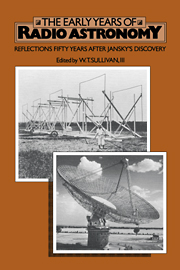Book contents
- Frontmatter
- Contents
- Preface
- THE EARLIEST YEARS
- Karl Jansky and the discovery of extraterrestrial radio waves
- Early radio astronomy at Wheaton, Illinois
- Optical and radio astronomers in the early years
- AUSTRALIA
- ENGLAND
- THE REST OF THE WORLD
- BROADER REFLECTIONS
- Biographical notes on contributors
- Name index
- Subject index
Optical and radio astronomers in the early years
Published online by Cambridge University Press: 05 March 2010
- Frontmatter
- Contents
- Preface
- THE EARLIEST YEARS
- Karl Jansky and the discovery of extraterrestrial radio waves
- Early radio astronomy at Wheaton, Illinois
- Optical and radio astronomers in the early years
- AUSTRALIA
- ENGLAND
- THE REST OF THE WORLD
- BROADER REFLECTIONS
- Biographical notes on contributors
- Name index
- Subject index
Summary
Radio noise from space was detected by Karl Jansky in 1931, working at the Bell Telephone Laboratories (Jansky 1933), This revolutionary discovery broke the barrier confining astronomical knowledge to the information contained, and the relevant physics, within the narrow band of wavelengths accessible (an octave and a half), and to positions and motions under purely gravitational forces. Jansky's wavelength was ten million times longer than that of light. His signals were radiated from the galactic center, 10,000 parsecs distant. The long wavelengths he used resulted in low angular resolution. There was no radial velocity information, no sharp spectral features (the first line was found twenty years later). For such reasons, and perhaps because he was an electrical engineer, no astronomer beat a pathway to his door; in fact I have never met any astronomer who personally knew him. Public recognition came only as an article in the New York Times (May 5, 1933) and a radio interview. His relevant bibliography includes only seven entries over the years 1932 to 1939, and he died young (see the article by Sullivan in this volume for further information on Jansky). As a summer resident of New Jersey seashore resorts in the early 1930s, I wore golf knickers, possibly even a hip flask, and drove an open car with a rumble seat (oh nostalgia!) past the giant antennas of the transatlantic radio transmitters for which Jansky's studies of noise background were to find the best operating wavelengths. Although I felt no premonitory twinges, I met my wife there, soon became interested in Jansky's results, and my life became linked with that place and time.
- Type
- Chapter
- Information
- The Early Years of Radio AstronomyReflections Fifty Years after Jansky's Discovery, pp. 67 - 82Publisher: Cambridge University PressPrint publication year: 1984
- 7
- Cited by



